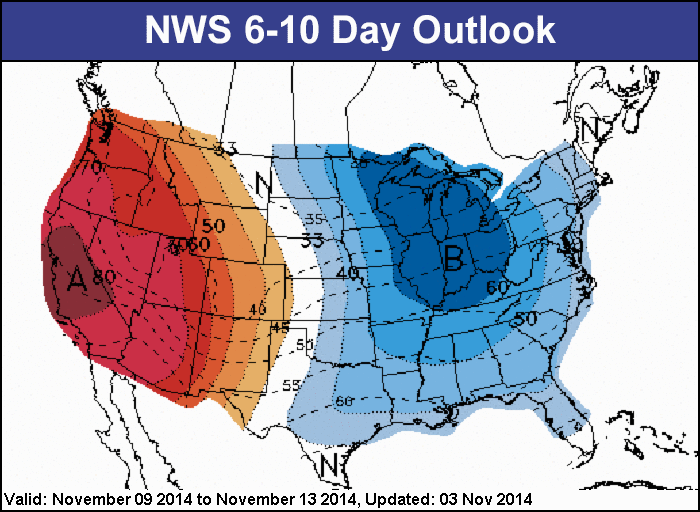NGI Archives | NGI All News Access
Weather Systems Bolster Northeast, Midwest Forwards Markets
Northeast and Midwest natural gas forwards markets screamed higher at the start of the week — posting gains of more than $1 at one market hub — as a series of weather systems are expected to give these areas the first real taste of winter.

The first two weather systems are forecast to hit this week, leaving behind rain and some snow showers, but next week’s Arctic blast will send temperatures below freezing and significantly boost heating demand.
Accuweather shows temperatures across much of the Northeast dropping to the 40s and 50s over the next two weeks, with overnight lows in the 20s and 30s.
“Once the cold becomes established, it will take several days to modify and return to near normal,” said forecasters with NatGasWeather.com. “This will provide a long enough period of strong heating demand to expect the first nat gas draw of the season following the final two builds. We expect additional cold blasts to follow into the third week of November, which should continue to provide bullish weather sentiment.”
“It’s definitely going to be cold. It’s just a matter of how intense,” a Northeast trader said.
The potential for sub-freezing conditions next week jolted forward prices in the affected regions by the most substantial levels so far this season. At New England’s Algonquin Gas Transmission citygates, December basis jumped about $1.50 between Monday and Wednesday to reach plus $13/MMBtu, according to NGI’s Forward Look. The balance of winter (January-March) shot up 85 cents to plus $13.67/MMBtu.
“It will be hard to top last year’s cold, but there are some forecasters who have January and February colder than the 10-year average,” another trader said, adding that the Northeast market is not one in which you want to go in short, especially given supportive weather forecasts.
Last winter it was reported that a number of players got caught short in the market, leading to record-setting gains in the Northeast forwards markets. And while banks have largely exited the commodities business, volatility will likely still abound this winter amid a lack of liquidity in the market, market sources said.
“Hedge funds haven’t completely stepped into the banks’ shoes,” the trader said. “There is still a void in liquidity without the banks. We get cold this winter, it will be evident.”
New York posted substantial gains as well, despite the availability of new capacity in the region that has yet to significantly impact production. Transcontinental Gas Pipe Line Zone 6-New York December basis climbed about 75 cents to plus $3.95/MMBtu, while the balance of winter soared some 87 cents to around plus $6.59/MMBtu.
At Texas Eastern Transmission Zone M3, December was up 27 cents to plus $1.10/MMBtu, and the balance of winter was up 12 cents to plus $2.55/MMBtu.
“Appalachian production has been running pretty steady at around 15.5 Bcf/d,” according to Genscape Senior Natural Gas Analyst Rick Margolin.
Meanwhile, the expectations for frigid weather also lifted Midwest prices. At the Chicago citygates, December basis jumped 20 cents between Monday and Wednesday to reach plus 59 cents/MMBtu, while the balance of winter picked up about 14 cents to hit plus 54 cents/MMBtu.
Points along the Northern Natural Gas Pipeline were up about 20 cents at the front of the curve, and the balance-of-winter packages were up between 10 and 20 cents.
“Later next week, when daily average temperatures are forecasted to range from 32 to 36 degrees, Genscape expects total Illinois demand to hit 4.6 Bcf/d,” Margolin said. “Flows into the market are expected to remain somewhat flat as the increase in demand will likely offset storage injections that occur behind the Nicor citygate.”
Most other markets remained relatively quiet the first week of November as temperatures were expected to stay mild and storage conditions continued to improve. The US Energy Information Administration reported a larger-than-expected 91 Bcf injection to storage stocks for the week ending Oct. 31.
© 2024 Natural Gas Intelligence. All rights reserved.
ISSN © 2577-9915 | ISSN © 2577-9877 |
